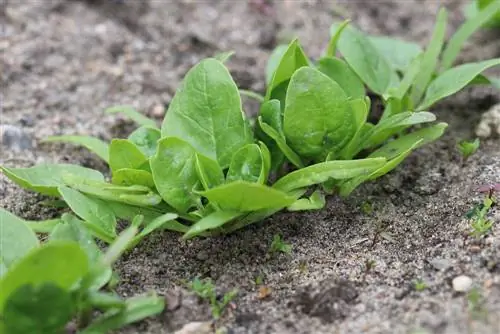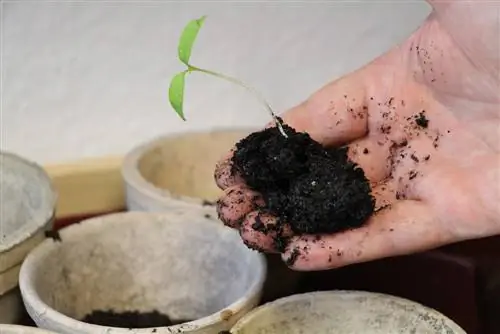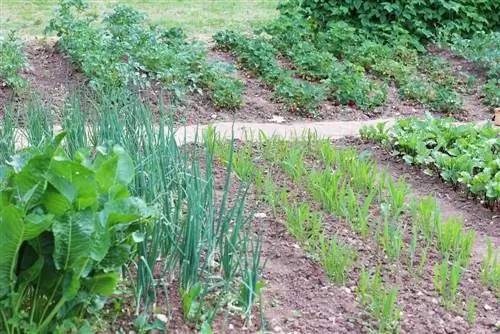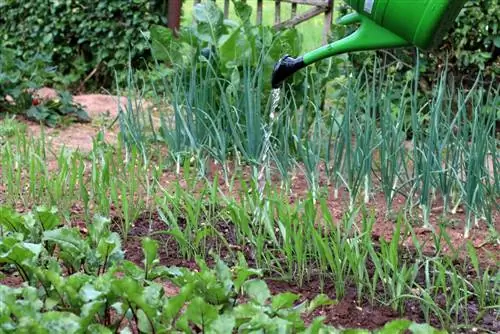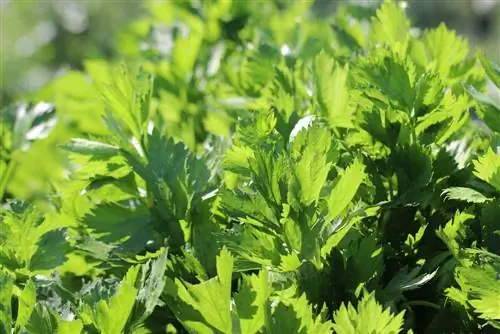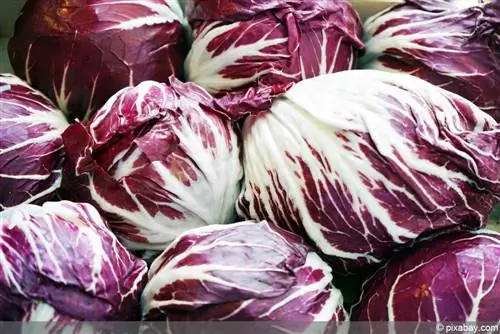- Author admin [email protected].
- Public 2023-12-17 03:39.
- Last modified 2025-01-24 12:45.
The delicious and he althy spinach has long been a very popular vegetable that can easily be grown in your own garden. The spinach plants are quite easy to care for, grow quickly and offer a rich harvest as they can be harvested four to five times in a year. The plants only require a little preparation of the garden bed and little care; it only takes a few weeks until they are ready to harvest. Children especially love the tasty spinach and it is even more he althy from your own garden.
Location
Spinach is sown in the normal garden bed, which usually has a sunny to partially shaded location. Spinach can also be cultivated in a raised bed, the advantage of which is that there is no need to bend over during any work or harvesting. The following beds can otherwise be chosen for growing spinach:
- as a pre-culture for many other vegetables
- as post-culture of strawberries, peas or new potatoes
- as a mixed culture with other vegetables
- Tomatoes, radishes, kohlrabi, radishes and potatoes are suitable for this
Tip:
If you don't have a garden or space on the terrace for a raised bed, you can also grow spinach in balcony boxes. Of course, the harvest is much smaller, but fresh vegetables from your own cultivation can also be brought to the table in this way.
Garden raised bed preparation
If the tasty spinach is to be sown in your own garden, the garden bed intended for this purpose should be prepared a few weeks before sowing. To do this, in early spring, when the ground is no longer frozen, compost and peat, cattle manure or horse manure are mixed with the existing soil and mixed well. The bed should then be worked with a soil rake and then with a rake to remove any large soil crumbs. A fine, crumbly substrate is required for sowing. The bed should be kept moist until sowing so that the seeds are not sown in dry soil.
Tip:
The garden or raised bed should be prepared about two to three weeks before sowing so that the soil can settle. The microorganisms living in the soil have time to decompose the organic fertilizer so that it can then be easily absorbed by the seeds and plants.
Substrate & Soil
The iron-rich and vitamin-rich spinach requires loose, nutrient-rich, humus-rich and moist soil. In addition, the substrate should have a neutral pH value between 6.5 and 7.5.
Time
The he althy spinach can be sown twice a year because there are different varieties. This is the right time for sowing:
- Early spinach in the months from March to May
- ready for harvest between April and early July
- Late spinach, on the other hand, is sown from August to September
- This will be ready for harvest in October
Tip:
If you choose both types of spinach, you can harvest for longer and bring fresh vegetables to your table until October.
Sowing
The seeds are sown in rows directly in the prepared garden or raised bed. Ideally, this should be done as follows:
- Draw rows
- for this, straight furrows are made through the bed with a hand shovel
- Distance between rows should be at least 15 cm depending on the variety
- The distance between the seeds to be planted should be between six and seven centimeters
- is sown more closely, has to be separated later
- Enter seeds one to three centimeters deep
- cover loosely with soil, do not press down or even step on it
- cover the bed with thin garden film in the first few weeks
- this offers optimal protection, especially from birds
- If the seedlings are robust enough, the foil can be removed
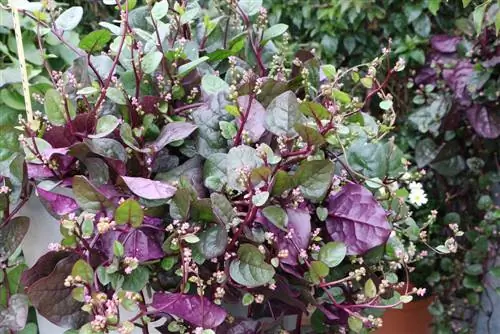
In order not to have to harvest all the spinach plants at the same time, the seeds can also be planted in the soil at a different time. There should always be about a week in between. This means that row by row can then be harvested one after the other. This process is particularly advantageous if the spinach is only to be used in the kitchen for everyday dishes. The situation is different if the spinach is to be processed as a whole and, for example, frozen for the winter. Then the entire seed can be sown in one bed at the same time.
Tip:
The rows for the spinach plants will be beautifully straight if a stick is placed in the ground at each end of the bed and a string is pulled from one side to the other.
Pouring
The soil in the garden or raised bed should always remain slightly moist, so the spinach should be watered regularly. Watering must be carried out in dry times, but waterlogging should be avoided. Spinach that has been left too dry for a long time begins to bloom early and is then unusable for harvest.
Fertilize
Preparing the soil with compost before sowing is particularly important for a rich harvest. After that, further fertilizer applications can usually be dispensed with.
Wintering
There are varieties of spinach that can be harvested very early in the year. To do this, they must be sown in September of the previous year. However, the young plants that have already developed before winter should be protected from frost and snow. If a cold frame is available for this, this is ideal. In spring, the spinach plants that are ready to harvest can be harvested immediately from the box. If sown in a garden bed, it should be covered with a transparent film over the winter. It is even better to build a frame over the bed over which the film is pulled. This allows the air to circulate better. Varieties that can be grown for overwintering in both spring and fall include:
- Matador
- Napoli F1
- Monopa
- Gamma
Obtaining seeds
Of course, the seeds used for sowing can not only be purchased from well-stocked garden shops, but can also be obtained yourself. If you have grown enough spinach plants in your garden bed, you can certainly do without one or two plants. This means that one or more plants are not harvested when they are ready for harvest but are left in the bed. After some time, these spinach plants form flowers from which the seeds can be obtained for the next cultivation. The procedure for obtaining the seeds is as follows:
- Making spinach plants bloom
- However, these are inedible for consumption
- become bitter after the flowers sprout
- this is due to the high nitrate concentration
- wait until the flowers have faded
- Cut off all inflorescences
- let continue to dry and ripen in a warm, dry place
- then simply remove them from the dried sepals
- Keep seeds cool and dry until needed for sowing
Tip:
However, obtaining your own seeds is only worthwhile if you have a large garden bed and you can do without some of the spinach plants. In order for the plants to form flowers more quickly, you can avoid watering even a small, separated part of the spinach bed so that the soil dries out.
Harvest
About eight weeks after sowing, the spinach plants are ready to harvest. The entire spinach plant should not be removed because it produces four to five times the yield in a year. Therefore, the following procedure should be followed when harvesting:
- cut individual leaves directly above the ground around the heart
- new leaves develop from the heart
- these can be harvested at any time
- constant pruning promotes growth
Spinach contains nitrate, which can also be toxic to the human body. Over the course of the day, this nitrate is converted into the plant's own substances via photochemical processes. Therefore, the nitrate concentration in the plants is lowest in the evening. Therefore, a harvest should ideally always take place in the evening, then the spinach leaves are most digestible for us humans.
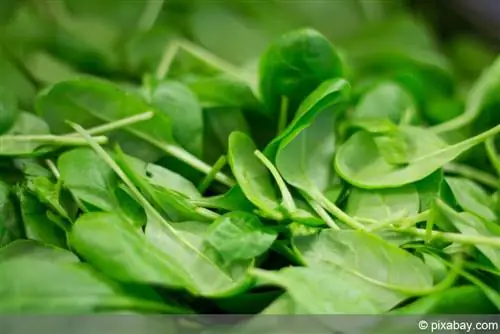
As soon as the spinach plants in a bed have been harvested several times or they start to flower, the entire bed can be harvested and all spinach plants can be pulled out. If there are still edible leaves on the plants, they can be used in the kitchen; the rest of the spinach plants are disposed of in the compost.
Diseases
The spinach plants are actually very robust, but diseases can still attack them. These include leaf spot, which is a fungal disease. The leaves become dry or wilted and have brown spots with a red border. These affected leaves should be completely removed and disposed of in household waste rather than compost. However, the remaining leaves can be harvested. Downy mildew can also occur, especially if the weather is very humid and cold. Please pay attention to the following:
- There is a white-gray coating on the underside of the leaf
- Yellowing of leaves
- brown or yellow spots on the upper side of the leaf
- remove the affected plants altogether
- Do not recycle, dispose of in residual waste
- Don't place plants too close together when sowing
- How to avoid downy mildew
Pests
The vegetable owl and the beet fly are known pests. The vegetable owl is a butterfly that likes to place its larvae on the late spinach plants that are harvested in autumn. The caterpillar larvae feed on the leaves and leave food damage behind. If the first holes are detected in the spinach plants, they should be examined for caterpillars and collected by hand. The beet flies, on the other hand, attack the young plants in spring. Please pay attention to the following:
- white eggs are laid on the undersides of leaves
- several generations per year
- An infestation can be expected until autumn
- The larvae then eat the leaves
- can be combated with insecticides
- In such a case, the spinach plants must be washed thoroughly before using them
Conclusion
Growing spinach is simple and easy; there is always fresh vegetables from your own garden on the table from spring to autumn. Especially when the various early and late spinach varieties are selected and sown in such a way that new, fresh plants are always ready to harvest. Since the plants grow quickly and you only have to pay attention to watering, only preparing the bed and sowing takes a little work.

